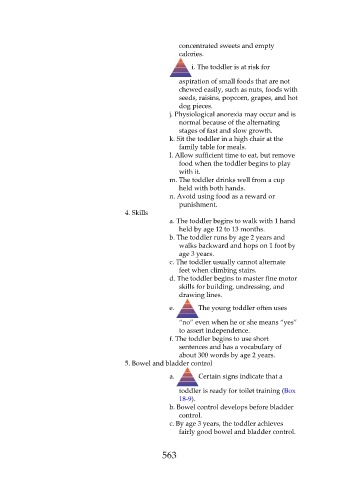Page 563 - Saunders Comprehensive Review For NCLEX-RN
P. 563
concentrated sweets and empty
calories.
i. The toddler is at risk for
aspiration of small foods that are not
chewed easily, such as nuts, foods with
seeds, raisins, popcorn, grapes, and hot
dog pieces.
j. Physiological anorexia may occur and is
normal because of the alternating
stages of fast and slow growth.
k. Sit the toddler in a high chair at the
family table for meals.
l. Allow sufficient time to eat, but remove
food when the toddler begins to play
with it.
m. The toddler drinks well from a cup
held with both hands.
n. Avoid using food as a reward or
punishment.
4. Skills
a. The toddler begins to walk with 1 hand
held by age 12 to 13 months.
b. The toddler runs by age 2 years and
walks backward and hops on 1 foot by
age 3 years.
c. The toddler usually cannot alternate
feet when climbing stairs.
d. The toddler begins to master fine motor
skills for building, undressing, and
drawing lines.
e. The young toddler often uses
“no” even when he or she means “yes”
to assert independence.
f. The toddler begins to use short
sentences and has a vocabulary of
about 300 words by age 2 years.
5. Bowel and bladder control
a. Certain signs indicate that a
toddler is ready for toilet training (Box
18-9).
b. Bowel control develops before bladder
control.
c. By age 3 years, the toddler achieves
fairly good bowel and bladder control.
563

